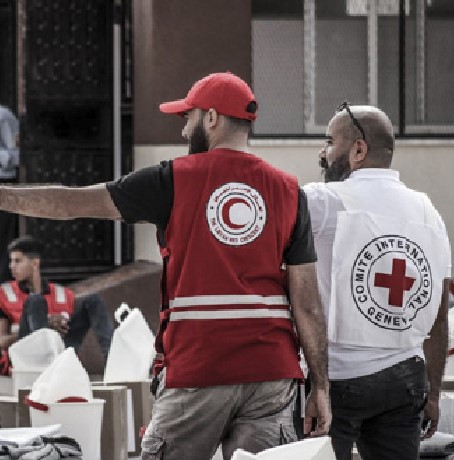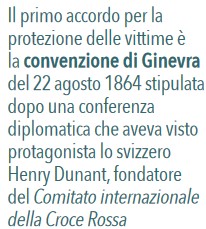On the side of humanity
Publish date 29-05-2023
The birth of international humanitarian law as a response to atrocities and war crimes

In the international community there is growing attention - and deserving! – for the protection of human rights. It originates in the regulatory instruments adopted after the tragedy of the Second World War.
However, there is another area of international law which takes into consideration the protection of the human person, but from a different perspective. This is international humanitarian law, the law of armed conflicts. The "jus in bello", the law "in war" is very ancient and has produced numerous regulations aimed at strengthening the awareness that war is violence, but this cannot be without limits.
The international law "of war", "of war", today "of armed conflicts" has developed in two directions. In the first place, the States have adopted multilateral conventions to regulate the exercise of warfare, to place limits on the conduct of hostilities, to prohibit certain means and methods of warfare, to ban certain types of weapons. Secondly, they adopted other conventions aimed at the protection of war victims, wounded, sick, shipwrecked, prisoners of war and civilians.
Customary norms had already been developed in remote times to set temperamenta belli (as Ugo Grozio wrote in 1625), to mitigate the brutality of war, but it is above all starting from the second half of the nineteenth century that the international community undertook a significant of elaboration of precise norms, codified in specific treaties. The first agreement to limit the violence of war is the St. Petersburg declaration of 1868, which bans explosive projectiles weighing less than 400 grams because they are weapons that cause "unnecessary suffering", and are therefore "contrary to the laws of humanity". . It is stated that the only legitimate aim of war is "to weaken the enemy's military forces" and to do this "it is enough to knock out as many soldiers as possible", and that it goes beyond the scope to use weapons that "they unnecessarily aggravate the suffering of men put out of action or make their death inevitable". The first agreement for the protection of victims is the Geneva Convention of 22 August 1864 "for the improvement of the fate of wounded soldiers" in land warfare, stipulated following a diplomatic conference in which the Swiss Henry Dunant, founder of the of the Red Cross, who was struck by the tragedy of the battlefield of Solferino (1859).
 From these first initiatives of the 1860s began the path that led to the stipulation of the Hague conventions of 1899 and 1907 and the Geneva conventions of 1906, 1929 and, above all, of 12 August 1949 (relating to the wounded, sick and shipwrecked, prisoners of war and the civilian population), supplemented by the additional protocols of 1977 on the protection of victims of international and non-international armed conflicts. To these have been added numerous conventions which prohibit certain weapons (from chemical and bacteriological weapons to anti-personnel mines
From these first initiatives of the 1860s began the path that led to the stipulation of the Hague conventions of 1899 and 1907 and the Geneva conventions of 1906, 1929 and, above all, of 12 August 1949 (relating to the wounded, sick and shipwrecked, prisoners of war and the civilian population), supplemented by the additional protocols of 1977 on the protection of victims of international and non-international armed conflicts. To these have been added numerous conventions which prohibit certain weapons (from chemical and bacteriological weapons to anti-personnel mines  and cluster munitions) or which introduce precise prohibitions, such as agreements for the protection of cultural property in armed conflicts.
and cluster munitions) or which introduce precise prohibitions, such as agreements for the protection of cultural property in armed conflicts.
The conspicuous body of legislation of the by now numerous conventions of international law of armed conflicts - which we now call "international humanitarian law" - has led to the consolidation of some fundamental principles. The most important (which the first Geneva Protocol of 1977 qualifies as a "fundamental rule") is the obligation to "make a distinction, at all times" between the civilian population and combatants, and between civilian objects and military objectives , and "consequently, direct operations only against military objectives".
Then there are the principle of limitation, which generally prohibits weapons or means that cause "superfluous harm or unnecessary suffering"; the precautionary principle in attacks, to minimize damage to civilians and their property; the principle of proportionality.
Contemporary conflicts dramatically highlight the need to recall the punctual respect of these norms. States, in principle, declare themselves convinced of this, and the Geneva Conventions of 1949, with 100% adherence, are the most ratified multilateral treaties in the world.
In the conflicts of these years, however, we are witnessing widespread violations of these principles and norms.
Some international institutions are active to promote knowledge of the rules and their respect. First of all, the International Committee of the Red Cross has its headquarters in Geneva which, together with the Federation of National Societies of the Red Cross and Red Crescent, disseminates knowledge of the conventions and operates on the battlefields. In Sanremo there is the International Institute of Humanitarian Law, which has been organizing training courses for thousands of officers of the armed forces from all over the world for half a century.
The images of violations of humanitarian law that come to us every day from bloodied Ukraine remind us of the need to recall the obligations to respect the Geneva conventions, in particular the IV, relating to the protection of civilians.
The warning of the declaration of St. Petersburg always remains alive, according to which "the progress of civilization must produce the effect of mitigating, as far as possible, the calamities of war".
Edoardo Greppi
NP Marzo 2023
 Comitato internazionale della Croce Rossa
Comitato internazionale della Croce Rossa
 Federazione delle Società Nazionali di Croce Rossa e Mezzaluna Rossa
Federazione delle Società Nazionali di Croce Rossa e Mezzaluna Rossa
 Istituto Internazionale di Diritto Umanitario
Istituto Internazionale di Diritto Umanitario







